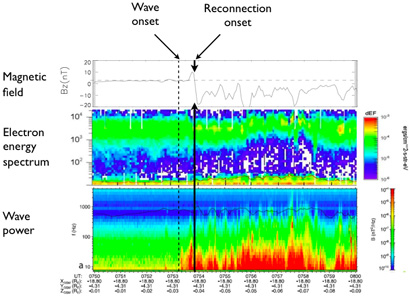Reconnection - Triggered by Whistlers?
9 June 2008
Some of the most explosive phenomena in the Universe are due to a physical process known as magnetic reconnection. Fundamental aspects of this process are still not fully understood but new advances, using Cluster data, have recently been reported by a team led by scientists from the Chinese Academy of Sciences.| Movie 1: Solar Flares |
Understanding magnetic reconnection is key to explaining explosive phenomena in space — such as solar flares (billion-megaton explosions in the Sun's atmosphere, see Movie 1) and gamma-ray bursts (intense bursts of radiation from exotic stars) — and on Earth (for example laboratory nuclear fusion). Just like a rubber band can suddenly snap when pulled too far, magnetic reconnection is a natural process by which the energy in a stressed magnetic field is suddenly released, projecting electron and ion jets. How magnetic energy can be released so quickly is a question that has perplexed scientists for several decades.
 |
| Figure 1: Magnetic reconnection scales |
In the 1990's, theoreticians found that in a narrow region close to a reconnection site (see light blue region in Figure 1), the electrons and protons move independently — instead of moving together, spiralling along magnetic field lines as they normally do. As a result, whistler waves are generated which can accelerate electrons to much higher velocities. In other words, a theoretical explanation was found for the fast release of magnetic energy during reconnection where whistlers play a key role (Drake et al, 2001).
(These waves were first heard by radio operators who called them whistlers — the wave velocity varies as the frequency, so high-frequency waves reach the operators first, resulting in a falling tone (Click here to listen to a Cluster whistler).)
A decade later observations with the Geotail satellite confirmed the presence of whistlers during a reconnection process captured at the border of the magnetosphere (Deng and Matsumoto, 2001). But a key question remains: why do magnetic fields involved in a reconnection process suddenly explode for no apparent reason after remaining apparently quiescent for long periods of time. In other words, what triggers magnetic reconnection?
On 21 August 2002, the constellation of Cluster satellites passed by a magnetic reconnection event, located some 120,000 km away from Earth — 1/3 of the distance to the Moon — near the center of the magnetotail (the night side of the magnetosphere). A recent study reports a detailed analysis of this event showing intense whistlers appearing about 30 seconds prior to reconnection. This is a potential triggering factor as they generate sufficient anomalous resistivity to allow magnetic reconnection to take place (for more on anomalous resistivity see "Cluster probes generalized Ohm's law").
The whistlers were found to be greatly enhanced when reconnection kicked off (Figure 2). In addition, as reconnection proceeded, the wave frequency became higher and higher. The fact that spectral characteristics of the whistler waves are observed to be different before and after the start of reconnection suggests that they were produced by different mechanisms.
"The data collected by the four Cluster satellites on 21 August 2002 suggest that whistler waves prior to reconnection may play an important role in triggering reconnection", says Dr. Jinbin Cao, corresponding author of this study published in the Journal of Geophysical Research.
"This new result will certainly help constrain theoreticians and their computer simulations to better model magnetic reconnection as detailed observations in space are scarce. However, the triggering of reconnection remains an open question. Future missions like the ESA/JAXA Cross-Scale project and the NASA MMS mission will hopefully provide the tools to pinpoint the triggering mechanism", underlines Philippe Escoubet, Cluster project scientist and Cross-Scale study scientist at the European Space Agency.
Related articles
Wei, X. H., et al, "Cluster observations of waves in the whistler frequency range associated with magnetic reconnection in the Earth’s magnetotail", J. Geophys. Res., 112, A10225, 2007, doi:10.1029/2006JA011771
Deng, X. H., & Matsumoto, H., "Rapid magnetic reconnection in the Earth's magnetosphere mediated by whistler waves", Nature, 410, 557-560, 2001, doi:10.1038/35069018
Drake, J. F., "Magnetic explosions in space", Nature, 410, 525-526, 2001, doi:10.1038/35069160
Contact
J. B. Cao, Key Laboratory of Space Weather, Center for Space Science and Applied Research, Chinese Academy of Sciences, Beijing, China
E-mail: jbcao cssar.ac.cn
cssar.ac.cn
X. H. Wei, Key Laboratory of Space Weather, Center for Space Science and Applied Research, Chinese Academy of Sciences, Beijing, China
E-mail: xhwei ns.spaceweather.ac.cn
ns.spaceweather.ac.cn
Web story author and co-editor
Arnaud Masson, Science Directorate, ESA, The Netherlands.
E-mail: Arnaud.Masson esa.int
esa.int
Phone: +31-71-565-5634
Web story editors
Philippe Escoubet, Science Directorate, ESA, The Netherlands.
E-mail: Philippe.Escoubet esa.int
esa.int
Phone: +31-71-565-4564
Matt Taylor, Science Directorate, ESA, The Netherlands.
E-mail: mtaylor rssd.esa.int
rssd.esa.int
Phone: +31-71-565-8009

